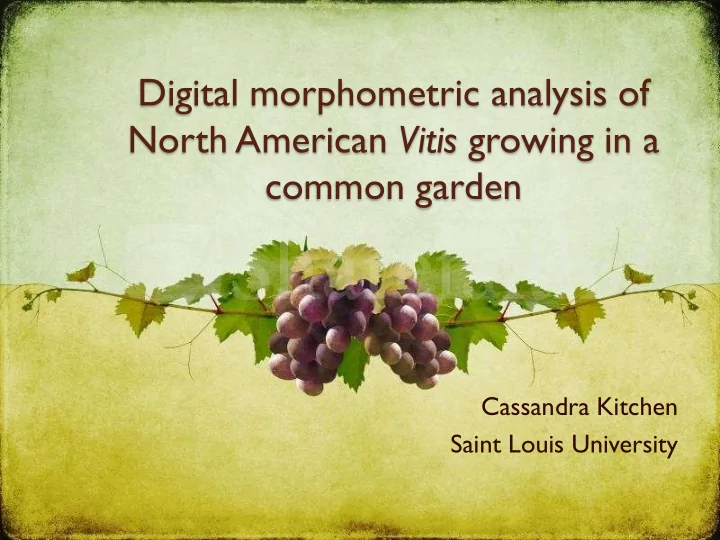

Digital morphometric analysis of North American Vitis growing in a common garden Cassandra Kitchen Saint Louis University
Introduction • Species within the genus Vitis (Vitaceae) are the foundation of wine, table grape, raisin, and grape juice industries ($billions) • Grapevine cultivation is based primarily on European V. vinifera which are grafted to North American Vitis species ( V. riparia, V. Phylloxera galls on V. rupestris at rupestris) the Missouri Botanical Garden • Since the Phylloxera infestion of the 1800s in Europe, N. American grapevines have been key genetic resources in developing biotic and abiotic stress resistant rootstocks
Introduction Leaf morphology is very diverse in the genus Vitis and has been used to differentiate species and varieties Environmental conditions impact leaf morphology, it is sometimes unclear if leaf morphology corresponds to V. rupestris in N. Missouri current species boundaries V. riparia and rupestris are 2 closely related N. American grape species with highly variable leaf morphology
Introduction Common gardens allow researchers to examine effects of environment on phenotypes among various taxa and genotypes from across the species’ geographic range The purpose of this study was to quantify leaf shape in multiple accessions of V. riparia and V. rupestris in a common environment null hypothesis: under common conditions there are no differences among species in leaf morphology
Methods A new leaf morphology analysis developed by Dan Chitwood at the Danforth Center to assess leaf shape in cultivated grapes was applied to wild species Leaves were collected from an experimental vineyard at the Missouri Botanical Garden (MBG) total of 64 plants with 4 V. riparia genotypes, 5 V. rupestris genotypes
Methods One primary shoot was selected per plant, all leaves from that shoot were removed Leaf order along the shoot was maintained The leaves were numbered in the analyzed images so that leaf number corresponded to position along the shoot
Methods Leaves were scanned Custom Image J V. riparia V. rupestris macros were used to extract outlines of leaves and to measure circularity and aspect ratios of leaves
Methods Analysis of leaf outlines was conducted using Elliptical Fourier Descriptors (EFDs) followed by Principal Components Analysis “Landmarked” leaf images were used for General (PCA) using the Procrustes Analysis (GPA) program SHAPE in R
Results EFDs display differences in V. riparia and V. rupestris leaf shape.
Results GPA demonstrated differences in vein branch points, sinus valleys, and lobe tips.
Results Aspect ratio and circularity measurements indicate that under common conditions these species differ in leaf shape, but there is a range of variation of leaf shape within each species. Rupestris leaves had higher aspect ratios; riparia had lower circularity values.
Conclusions: Circularity and Aspect Ratios AR: rupestris had lower length-to- width ratios Circ: riparia had increased lobing and serration V. riparia V. rupestris
Conclusions Digital leaf morphometrics developed for cultivated V. vinifera ssp. vinifera can be used to differentiate closely related Vitis species Under common conditions, multiple genotypes of V. riparia and rupestris differ in leaf shape
Future Work Leaf shape data from the common garden will be integrated with transcriptome data, ion concentration data, and water use efficiency data to understand how perennial plants respond to fluxuating climatic conditions
Acknowledgements This study was funded through an NSF REU grant to MBG. The research vineyard was established by the Saint Louis University Center for Sustainability and MBG. Thanks to Allison Miller, David Bogler, Dan Chitwood, Laura Klein, and others at MBG for their help with this study.
Recommend
More recommend